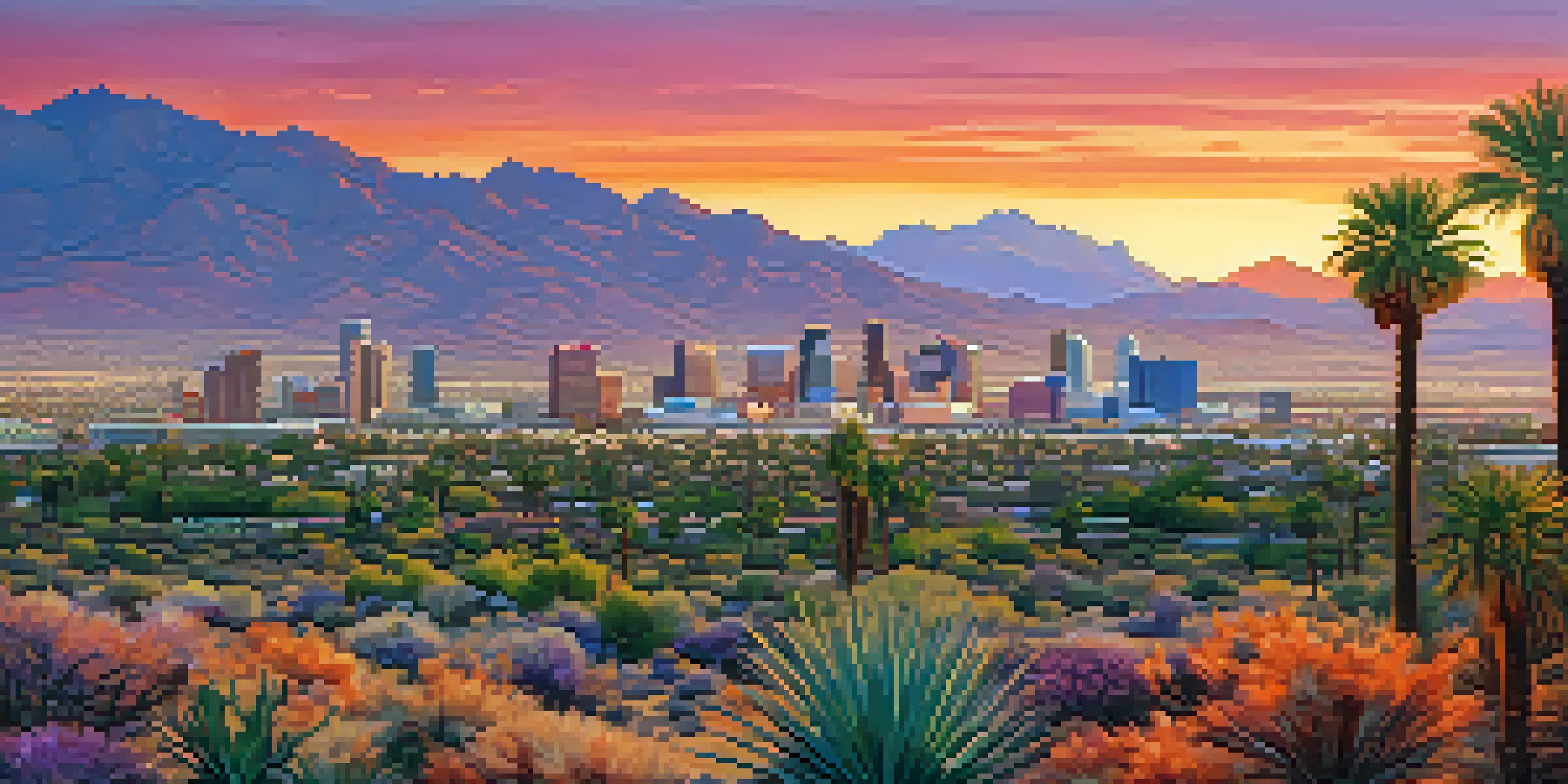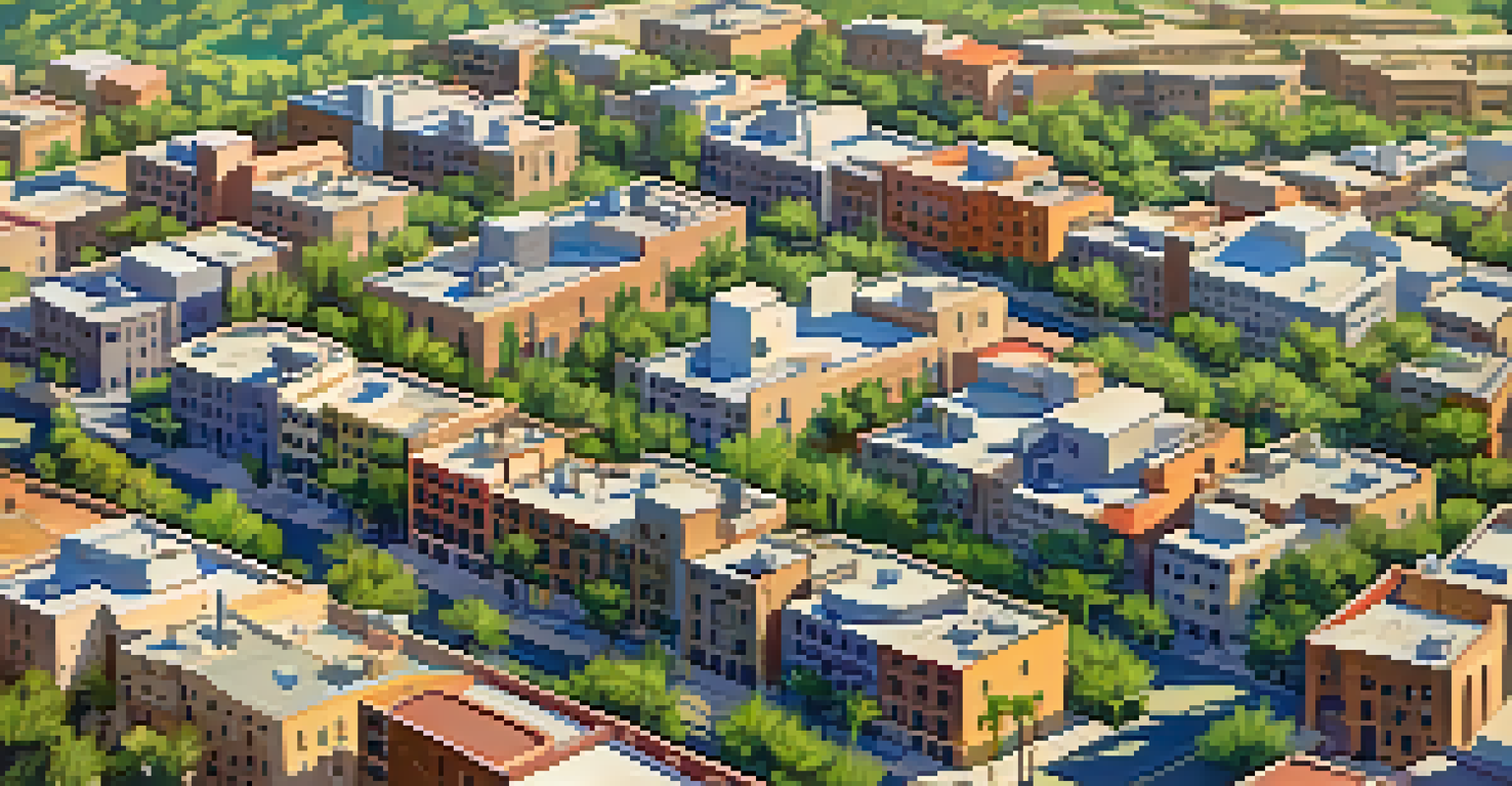Impact of Urbanization on Arizona's Climate and Weather Patterns

Understanding Urbanization and Its Drivers in Arizona
Urbanization refers to the increasing population in urban areas, leading to the expansion of cities. In Arizona, factors like job opportunities, quality of life, and education attract many residents to urban centers like Phoenix and Tucson. This influx results in significant changes to the landscape and local environment, which can impact climate and weather patterns.
Urbanization is not just about the growth of cities; it's about the impact on the environment and the quality of life of its residents.
As more people move into urban areas, the demand for housing and infrastructure grows, leading to increased construction and land use changes. This development often replaces natural landscapes with concrete, asphalt, and buildings. Such transformations can alter the local climate, affecting temperature and precipitation patterns.
Moreover, urban areas tend to create their own microclimates, often referred to as 'urban heat islands'. These regions can experience higher temperatures than surrounding rural areas due to human activities and the materials used in construction. Understanding these dynamics is crucial for addressing climate challenges in the state.
Impact of Urban Heat Islands on Arizona's Climate
Urban heat islands (UHIs) are a phenomenon where urban areas experience significantly warmer temperatures than their rural counterparts. In Arizona, the development of cities like Phoenix has led to the creation of UHIs, which can increase local temperatures by several degrees. This warming effect not only affects comfort levels but also has broader implications for energy consumption and health.

As temperatures rise, the demand for air conditioning and energy spikes, leading to increased greenhouse gas emissions. This cycle can exacerbate climate change, creating a feedback loop that further intensifies urban heat. For Arizona residents, this means dealing with hotter summers and potentially more severe heat-related health issues.
Urban Heat Islands Raise Temperatures
The development of urban areas in Arizona contributes to higher local temperatures, creating urban heat islands that impact energy consumption and health.
Additionally, UHIs can influence weather patterns by altering local wind flows and precipitation distributions. The changes in temperature can affect cloud formation and storm patterns, leading to unpredictable weather events that challenge traditional forecasting methods. This complexity makes it essential to consider UHI effects in climate planning and management.
Changes in Precipitation Patterns Due to Urbanization
Urbanization in Arizona has not only increased temperatures but has also altered precipitation patterns. The expansion of impervious surfaces, like roads and parking lots, prevents water from soaking into the ground, leading to more runoff. This can result in flash floods during heavy rains, a significant concern in desert regions where water management is critical.
The most important thing about a city is its people and their ability to adapt to change.
Moreover, urban areas tend to experience a phenomenon known as 'rain shadow effect.' This occurs when urban structures disrupt wind patterns, potentially causing precipitation to bypass certain areas. As a result, some neighborhoods may receive less rain, which can affect local agriculture and water supply.
Understanding these changes in precipitation is vital for urban planning and resource management in Arizona. Communities need to develop strategies that address both flood risks and water scarcity, ensuring a sustainable future despite the challenges posed by urbanization.
Biodiversity Loss and Urbanization in Arizona
Urbanization often leads to habitat destruction, which can threaten local biodiversity. In Arizona, the encroachment of urban areas into natural habitats has resulted in the decline of various plant and animal species. As natural ecosystems are fragmented by development, many species struggle to adapt or find suitable living conditions.
This loss of biodiversity can have cascading effects on the environment, including reduced pollination, altered food webs, and diminished resilience to climate change. For instance, native species that help control pests may decline, leading to increased reliance on chemical pesticides in urban gardens and agricultural areas.
Urbanization Alters Precipitation Patterns
The expansion of impervious surfaces in urban areas leads to increased runoff and changes in precipitation patterns, causing flash floods and water scarcity.
To mitigate these impacts, urban planners and communities must prioritize green spaces and wildlife corridors. By integrating nature into city designs, Arizona can foster a healthier environment that supports both its residents and local wildlife, creating a balance between urban growth and ecological preservation.
Air Quality Deterioration in Urban Areas of Arizona
As urbanization accelerates in Arizona, air quality has become a pressing concern. Increased vehicle emissions, industrial activities, and construction dust contribute to higher levels of pollutants in the air. Poor air quality can lead to respiratory issues and other health problems for residents, especially vulnerable populations like children and the elderly.
Additionally, the phenomenon known as temperature inversion can worsen air quality in urban areas. During these events, warmer air traps pollutants close to the ground, preventing them from dispersing. In Arizona's hot climate, this can lead to smoggy conditions, particularly during the summer months.
Addressing air quality issues requires collaborative efforts from government agencies, businesses, and residents. Implementing stricter emissions standards, promoting public transportation, and encouraging green spaces can significantly improve air quality and enhance the overall quality of life in urban Arizona.
Water Scarcity and Urbanization Challenges in Arizona
Water scarcity is a significant challenge for Arizona, especially as urban populations continue to grow. The demand for water in urban areas can outstrip available resources, leading to conflicts between agricultural, residential, and industrial needs. This situation is exacerbated by climate change, which can alter precipitation patterns and reduce water availability.
Urban areas often require extensive water infrastructure, from reservoirs to treatment plants, to manage supply effectively. However, maintaining this infrastructure can be costly and complex, especially in arid regions like Arizona. As cities expand, ensuring sustainable water management practices becomes increasingly critical.
Biodiversity Loss from Urban Growth
Urbanization in Arizona threatens local biodiversity by fragmenting natural habitats, which can disrupt ecosystems and reduce resilience to climate change.
To combat water scarcity, Arizona's urban planners must promote conservation measures, such as rainwater harvesting and xeriscaping, which uses drought-resistant plants. By fostering a culture of water conservation, communities can ensure access to this vital resource for future generations, even in the face of urban growth.
The Role of Policy in Managing Urbanization's Climate Effects
Effective policy is essential for managing the impacts of urbanization on climate and weather in Arizona. Local governments play a crucial role in developing regulations that promote sustainable development, protect natural resources, and mitigate the effects of urban heat islands and pollution. Without thoughtful policy initiatives, urban growth can lead to unintended environmental consequences.
Community engagement is also vital in shaping these policies. Involving residents in discussions about urban planning and sustainability can lead to more effective solutions that reflect the needs and values of the population. For instance, public input can guide the creation of green spaces and transportation options that reduce reliance on automobiles.

Finally, collaboration between state, local, and federal agencies is necessary to address the multifaceted challenges posed by urbanization. By working together, these entities can develop comprehensive strategies that not only tackle immediate climate issues but also foster long-term resilience against future environmental changes.